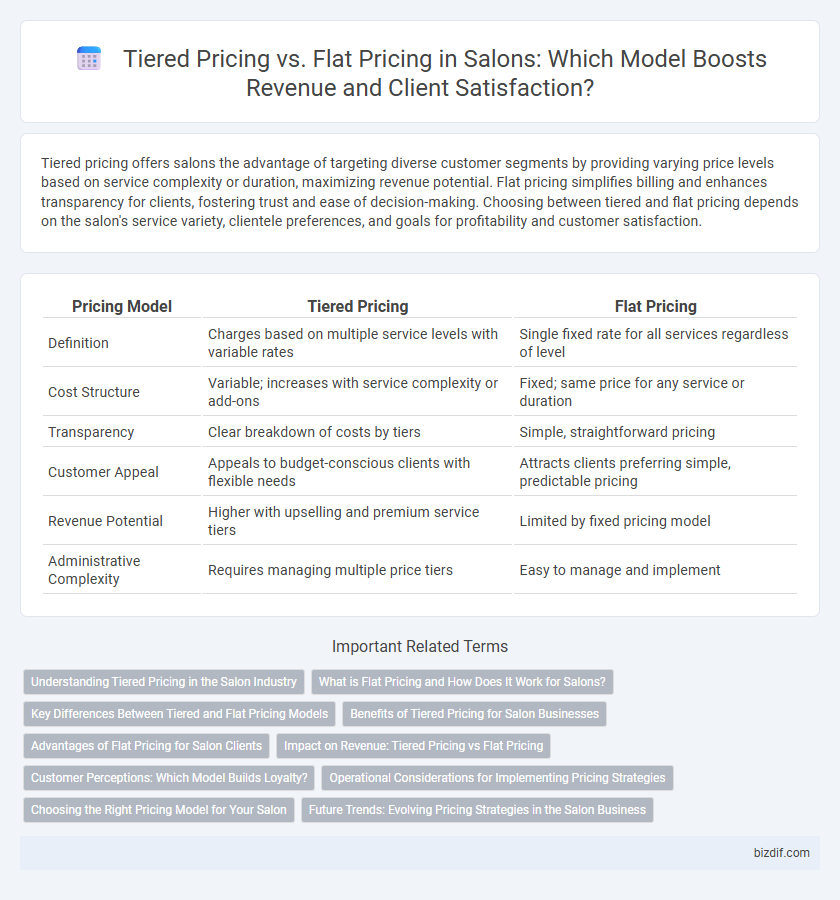Tiered pricing offers salons the advantage of targeting diverse customer segments by providing varying price levels based on service complexity or duration, maximizing revenue potential. Flat pricing simplifies billing and enhances transparency for clients, fostering trust and ease of decision-making. Choosing between tiered and flat pricing depends on the salon's service variety, clientele preferences, and goals for profitability and customer satisfaction.
Table of Comparison
| Pricing Model | Tiered Pricing | Flat Pricing |
|---|---|---|
| Definition | Charges based on multiple service levels with variable rates | Single fixed rate for all services regardless of level |
| Cost Structure | Variable; increases with service complexity or add-ons | Fixed; same price for any service or duration |
| Transparency | Clear breakdown of costs by tiers | Simple, straightforward pricing |
| Customer Appeal | Appeals to budget-conscious clients with flexible needs | Attracts clients preferring simple, predictable pricing |
| Revenue Potential | Higher with upselling and premium service tiers | Limited by fixed pricing model |
| Administrative Complexity | Requires managing multiple price tiers | Easy to manage and implement |
Understanding Tiered Pricing in the Salon Industry
Tiered pricing in the salon industry allows businesses to charge different rates based on service complexity, stylist expertise, or appointment duration, optimizing revenue while catering to diverse customer needs. This pricing model enhances client satisfaction by offering flexible options, from basic haircuts to advanced treatments, aligned with the stylist's skill level. Compared to flat pricing, tiered pricing can increase profitability by incentivizing stylists and better matching prices to service value.
What is Flat Pricing and How Does It Work for Salons?
Flat pricing in salons involves charging a fixed rate for specific services regardless of time or complexity, providing transparent and predictable costs for clients. This pricing model simplifies billing, enhances customer trust, and streamlines salon operations by reducing the need for detailed service breakdowns. Salons using flat pricing often attract clients who prefer straightforward pricing without unexpected charges.
Key Differences Between Tiered and Flat Pricing Models
Tiered pricing models in salons charge customers based on service levels or quantities, offering discounts or premium rates depending on the tier chosen, while flat pricing applies a single fixed rate for all customers regardless of usage. Tiered pricing provides flexibility and incentivizes customers to purchase higher-tier services, increasing revenue potential, whereas flat pricing simplifies billing and enhances transparency but may limit profit maximization. Salons using tiered pricing can adapt to diverse customer needs and service complexities, unlike flat pricing which is straightforward but less customizable.
Benefits of Tiered Pricing for Salon Businesses
Tiered pricing in salon businesses maximizes revenue by catering to diverse customer preferences and budgets, fostering higher client retention and satisfaction. It allows salons to efficiently manage service offerings, from basic cuts to premium treatments, enhancing flexibility and perceived value. Implementing tiered pricing also supports targeted marketing strategies, driving increased bookings and improved profit margins.
Advantages of Flat Pricing for Salon Clients
Flat pricing in salons offers clients transparent, predictable costs that simplify budgeting for services like haircuts, coloring, and treatments. This pricing model eliminates surprises or hidden fees, enhancing trust and satisfaction while allowing clients to easily compare services. By standardizing prices, salons also speed up the booking process, ensuring a seamless and efficient customer experience.
Impact on Revenue: Tiered Pricing vs Flat Pricing
Tiered pricing in salons maximizes revenue by aligning services with client willingness to pay, increasing average transaction values and encouraging upsells. Flat pricing simplifies billing but may limit revenue growth by not capturing the full spending potential of diverse clientele. Implementing tiered pricing strategically boosts profitability through tailored service offerings and enhanced customer segmentation.
Customer Perceptions: Which Model Builds Loyalty?
Tiered pricing enhances customer loyalty by offering personalized options that meet diverse needs, fostering a sense of value and exclusivity. Flat pricing provides transparency and simplicity, appealing to clients who prefer straightforward, predictable costs. Salons implementing tiered pricing often report higher repeat visits and satisfaction due to perceived customization and rewards.
Operational Considerations for Implementing Pricing Strategies
Implementing tiered pricing in salons requires precise service differentiation, staff training, and dynamic scheduling to manage varying price points effectively. Flat pricing streamlines operations by simplifying billing and reducing administrative burdens, but may limit revenue flexibility across diverse client segments. Operationally, tiered pricing demands robust systems for tracking service levels and customer preferences, whereas flat pricing prioritizes efficiency and ease of implementation.
Choosing the Right Pricing Model for Your Salon
Choosing the right pricing model for your salon depends on factors like client preferences, service variety, and business goals. Tiered pricing offers flexibility with multiple service levels, attracting diverse clientele and maximizing revenue by catering to different budgets. Flat pricing provides simplicity and consistency, making it easier to manage bookings and client expectations, especially for salons with standard service offerings.
Future Trends: Evolving Pricing Strategies in the Salon Business
Tiered pricing in salons offers clients tailored service options based on skill level or service complexity, enhancing customer satisfaction and revenue potential. Flat pricing simplifies customer decisions by providing fixed rates for standard services, appealing to price-sensitive clients seeking transparency. Future trends indicate salons will increasingly adopt dynamic, technology-driven pricing models that integrate tiered and flat pricing, leveraging data analytics for personalized offers and competitive advantage.
Tiered Pricing vs Flat Pricing Infographic

 bizdif.com
bizdif.com